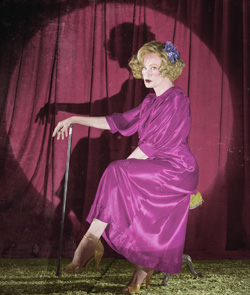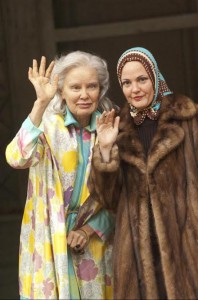Jessica Lange’s Abject Femininity
 It should come as no surprise that the most recent season of American Horror Story—subtitled Freak Show—features Jessica Lange as Elsa, a monstrous mother figure who dominates and manipulates her (surrogate) children, trampling them beneath her own delusions of grandeur. This is, after all, a role that has become a central part of Lange’s star persona and one that seems particularly suited to her acting style. This particular style—a mix of quirkiness, scenery-chewing, and vulnerability—can be seen in many of her recent television ventures, beginning most noticeably with HBO’s Grey Gardens and continuing through each season of American Horror Story, bringing a measure of complexity to these monstrous mother figures. As a result, rather than reinforcing a damaging trope continually enshrined in pop psychiatric discourse, these characters emerge as complex and quasi-sympathetic victims of the male-dominated world they inhabit.
It should come as no surprise that the most recent season of American Horror Story—subtitled Freak Show—features Jessica Lange as Elsa, a monstrous mother figure who dominates and manipulates her (surrogate) children, trampling them beneath her own delusions of grandeur. This is, after all, a role that has become a central part of Lange’s star persona and one that seems particularly suited to her acting style. This particular style—a mix of quirkiness, scenery-chewing, and vulnerability—can be seen in many of her recent television ventures, beginning most noticeably with HBO’s Grey Gardens and continuing through each season of American Horror Story, bringing a measure of complexity to these monstrous mother figures. As a result, rather than reinforcing a damaging trope continually enshrined in pop psychiatric discourse, these characters emerge as complex and quasi-sympathetic victims of the male-dominated world they inhabit.
Lange’s recent television work traces back to the emotionally resonant HBO film Grey Gardens, a retelling of the famous Maysles documentary about the fraught-yet-loving relationship between the two Beale women, Big and Little Edie. Though Little Edie (Drew Barrymore) desperately desires fame on the stage and on the screen, she constantly finds herself drawn back to her mother, until both of them are at last trapped in their formerly grand East Hampton mansion, locked in a deeply pathological yet strangely resonant relationship. In AHS: Asylum, likewise, Lange’s Sister Jude stops at nothing until she has managed to imprison hard-hitting, lesbian journalist Lana Winters, only to eventually find herself a prisoner of her asylum, betrayed by the very monsignor she had once served so faithfully.
 In both cases, Lange’s characters slowly slide from positions of independence and dominance into those of abjection, literally and physically cast out and isolated from the social world, typically as a result of the uncaring men in their lives. Big Edie of Grey Gardens, when faced with the rejection of both her husband and her lover, eventually decides to retreat from the world that has rejected her, staying in the crumbling mansion of Grey Gardens and preferring the ruins of its former glory to the harshness of the outside world. Sister Jude of AHS: Asylum likewise goes from the punishing and domineering matriarch of her domain into a prisoner of the very system she helped to create, trapped and ensnared in a dark cell, forgotten by almost everyone. Yet even she attains a measure of redemption, forgiven by the very people she worked so hard to keep in the asylum.
In both cases, Lange’s characters slowly slide from positions of independence and dominance into those of abjection, literally and physically cast out and isolated from the social world, typically as a result of the uncaring men in their lives. Big Edie of Grey Gardens, when faced with the rejection of both her husband and her lover, eventually decides to retreat from the world that has rejected her, staying in the crumbling mansion of Grey Gardens and preferring the ruins of its former glory to the harshness of the outside world. Sister Jude of AHS: Asylum likewise goes from the punishing and domineering matriarch of her domain into a prisoner of the very system she helped to create, trapped and ensnared in a dark cell, forgotten by almost everyone. Yet even she attains a measure of redemption, forgiven by the very people she worked so hard to keep in the asylum.
As this season of American Horror Story has unfolded, we have seen Elsa exhibit many of the traits of her predecessors, though Elsa is even more prone to violent changes in emotional state, wavering between (apparent) devotion to her “monsters”—the term she uses to discuss the other members of the troupe—and terrible fits of rage in which she threatens to destroy the life they have sought so hard to build. And yet, for all of her cruelty, we as viewers also know that Elsa deserves some measure of sympathy, given that we know (even if some of the characters don’t) that she was brutally tortured and lost her legs as a result. Of course, it remains to be seen just how far Elsa will fall in this season, but the odds are it will be pretty low, and she may not be granted salvation.
These texts clearly encourage the viewer to understand these falls from grace as not only deserved, but also as the logical extension of these domineering mothers’ own attempts to imprison their children into their own world. However, despite the fact that the narratives of these series consistently position us as viewers to condemn and dislike these dominating and destructive mothers, Lange’s acting style manages to inject a poignancy into these otherwise pathetic and destructive figures, the charming and quirky vulnerability oscillating uncertainly with the enraged scenery-chewing, consistently prompting the viewer to re-evaluate and reconsider their feelings about these characters.
Big Edie, for all of her flaws as a mother unwilling to let her daughter experience life outside of her care, nevertheless resists her sons’ attempts to remove her from the only space that she owns in her own right (even going so far as to assert that the only way she will leave the house is feet first). Likewise, she refuses to obey the stuffy social conventions imposed upon her by her dour husband. As viewers we may not entirely agree with all that she does; we may even grow frustrated with her. Likewise, Sister Jude (and many of Lange’s other AHS creations) begins as a ruthless tyrant but gradually reveals her depth, as we learn about her troubled past and the genuineness of her beliefs.
Lange’s acting style brings to mind the over-wrought, highly melodramatic acting personae of women like Joan Crawford and Bette Davis, both of whom also became famous for their willingness to portray abject femininity and their ability to wring pathos from their viewers. Lange’s evocation of the styles and sensibilities of the classic era of melodrama, I suspect, is in large part responsible for the wide variety of complex (and sometimes contradictory) responses her characters evoke. While this does not necessarily undo all of the damage that such representations bear with them, it does encourage us to consider more deeply and complexly the socio-cultural forces that grant these representations their purchase and to move beyond the more condemnatory mindset that most of these narratives typically carry with them.


